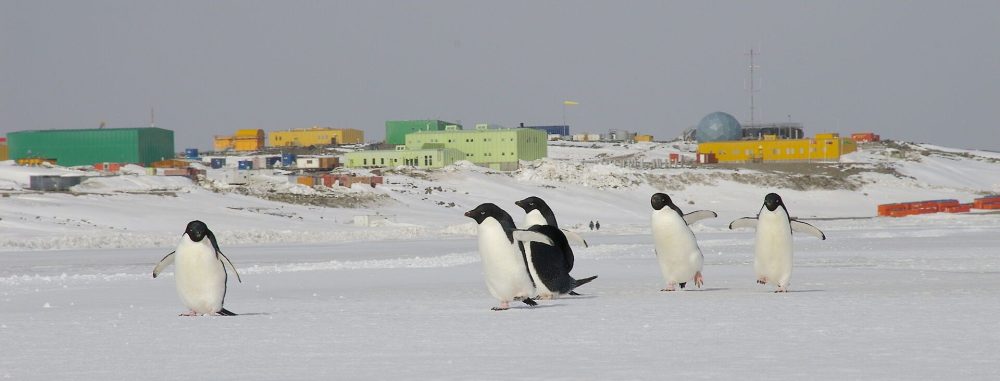 |
A 50 Mhz multimode Antarctic radio beacon has been installed at Esperanza Base (WAP ARG-Ø4), Argentine Antarctic Territory. Locator: GC16MO
 The purpose of the radio beacon is to provide the world’s radio amateur community with a tool
The purpose of the radio beacon is to provide the world’s radio amateur community with a tool
for propagation studies and detect openings in the 6m band, operating 24 hours a day all year
from the Esperanza Joint Antarctic Base in Argentine Antarctic Territory.
For this purpose, a new concept of operation was designed to take advantage of the automatic reception and recording systems that operate in the world such as PSK Reporter and CW.
Skimmer and at the same time that it can be received by radio amateurs that operate in FT8 and Morse code radiotelegraphic mode. auditory reception in real time.
For this purpose, the 50.313 MHz radio frequency was selected, which is the one used in FT8 mode and with the most traffic in the world.
 The FT8 signal is emitted at 2500 Hz so as not to affect normal QSO traffic, likewise the CW signal is emitted at the same frequency to be detected manually or automatically by other systems. In FT8 mode it is broadcast both in odd and even sequence to allow its reception regardless of the operational configuration of the radio amateurs at any given time. The broadcast sequence is:
The FT8 signal is emitted at 2500 Hz so as not to affect normal QSO traffic, likewise the CW signal is emitted at the same frequency to be detected manually or automatically by other systems. In FT8 mode it is broadcast both in odd and even sequence to allow its reception regardless of the operational configuration of the radio amateurs at any given time. The broadcast sequence is:
Chronogram according to the seconds of the minute.
00) CQ BCN LU1ZV GC16 (en FT8)
15) ESPERANZA BCN (en FT8)
30) VVV DE LU1ZV BCN GC16 AR (en CW)
45) stand by.
Transmit power: 3W, Half wave dipole antenna on sloper facing north.
Conceptual design: Andrés Travainni LU3HO & Alejandro Alvarez LU8YD
Hardware and software design, as well as Construction and donation: Andrés Travainni LU3HO
Antenna: Alejandro Alvarez LU8YD
Installation at Base Esperanza: Alejandro Alvarez LU8YD, Juan Benavente LU8DBS and Alejandro Petrecca
TNX Alejandro Alvarez LU8YD
Une balise radio antarctique multimode de 50 Mhz a été installée à la base d’Esperanza (WAP ARG-Ø4),
Territoire antarctique argentin. Localisateur : GC16MO
 Le but de la balise radio est de fournir à la communauté mondiale des radioamateurs un outil
Le but de la balise radio est de fournir à la communauté mondiale des radioamateurs un outil
pour les études de propagation et la détection des ouvertures dans la bande 6m, fonctionnant 24h/24 toute l’année
depuis la base antarctique conjointe d’Esperanza dans le Territoire antarctique argentin.
A cet effet, un nouveau concept de fonctionnement a été conçu pour tirer parti des systèmes de réception et d’enregistrement automatiques qui fonctionnent dans le monde tels que PSK Reporter et CW.
Skimmer et en même temps qu’il peut être reçu par des radioamateurs qui fonctionnent en mode radiotélégraphique FT8 et code Morse. réception auditive en temps réel.
A cet effet, la fréquence radio 50,313 MHz a été sélectionnée, qui est celle utilisée en mode FT8 et avec le plus de trafic au monde.

Le signal FT8 est émis à 2500 Hz afin de ne pas affecter le trafic QSO normal, de même le signal CW est émis à la même fréquence pour être détecté manuellement ou automatiquement par d’autres
systèmes. En mode FT8, il est diffusé à la fois en séquence paire et impaire pour permettre sa réception indépendamment de
la configuration opérationnelle des radioamateurs à un moment donné. La séquence de diffusion est :
Chronogramme selon les secondes de la minute.
00) CQ BCN LU1ZV GC16 (et FT8)
15) ESPERANZA BCN (et FT8)
30) VVV DE LU1ZV BCN GC16 AR (en CW)
45) en attente.
Puissance d’émission : 3 W, antenne dipôle demi-onde sur pente orientée vers le nord.
Design conceptuel : Andrés Travainni LU3HO & Alejandro Alvarez LU8YD
Conception matérielle et logicielle, ainsi que Construction et donation: Andrés Travainni LU3HO
Antenne : Alejandro Alvarez LU8YD
Installation à Base Esperanza : Alejandro Alvarez LU8YD , Juan Benavente LU8DBS et Alejandro Petrecca
TNX Alejandro Alvarez LU8YD
Info de la Source Publié * ICI
